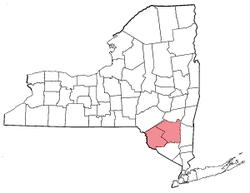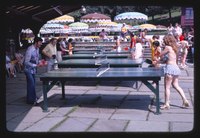Cultural region of United States
Borscht Belt |
|---|
|
 Areas of upstate New York that constituted the Borscht Belt |
| Country |  United States United States |
|---|
| State |  New York New York |
|---|
The Borscht Belt, or Yiddish Alps, is a colloquial term for the mostly defunct summer resorts of the Catskill Mountains in parts of Sullivan, Orange, and Ulster counties in the U.S. state of New York, straddling both Upstate New York and the northern edges of the New York metropolitan area. A source interviewed by Time magazine stated that visits to the area by Jewish families were already underway "as early as the 1890s ... Tannersville ... was 'a great resort of our Israelite breathren [sic]'...from the 1920s on [there were] hundreds of hotels."[1]
A 2019 review of the history is more specific: "in its heyday, as many as 500 resorts catered to guests of various incomes."[2] These resorts, as well as the Borscht Belt bungalow colonies, were a popular vacation spot for New York City Jews from the 1920s through the 1960s.[3] By the late 1950s, many began closing, with most gone by the 1970s, but some major resorts continued to operate, a few into the 1990s. Grossinger's Catskill Resort Hotel closed in 1986[4] while the Concord Resort Hotel struggled to stay open until 1998 and was subsequently demolished for a possible casino site.[2]
History
In the 1920s and 1930s, some hotels and resorts' advertisements refused to accept Jews and indicated "No Hebrews or Consumptives" in their ads. This discrimination led to a need for alternative lodging that would readily accept Jewish families as guests. One report states that the larger hotels provided "Friday night and holiday services as well as kosher cooking."[6][7]
At the hotels, "food was of primary importance ... there was a sense that ‘too much was not enough,'" according to one source.[8] "To understand the emphasis on food," writes Johnathan Sarna, "one has to understand hunger. Immigrants had memories of hunger, and in the Catskills, the food seemed limitless."[9]
The singles scene was also important; many hotels hired young male college students[10] to attract single girls of a similar age. One book on the era contended that the Catskills "became one great marriage broker."[11]
Borscht Belt hotels, bungalow colonies, summer camps, and kuchaleyns (a Yiddish name for self-catered boarding houses) flourished. The bungalows usually included
"a kitchen/living room/dinette, one bedroom, and a screened porch" with entertainment being simple: bingo or a movie.[12] The kuchaleyns were also often visited by middle-class and working-class Jewish New Yorkers. Because of the many Jewish guests, this area was nicknamed the Jewish Alps and "Solomon County" (a modification of "Sullivan County") by many people who visited there.[13]
Borscht Belt resorts stood in towns such as Liberty, Fallsburg, Mamakating, Thompson, Bethel and Rockland in Sullivan County as well as Wawarsing and Rochester in Ulster County. Such resorts included Avon Lodge, Brickman's, Brown's, Butler Lodge, The Concord, Grossinger's, Granit, the Heiden Hotel, Irvington, Kutsher's Hotel and Country Club, the Nevele, Friar Tuck Inn, the Laurels Hotel and Country Club, the Pines Resort, Raleigh Hotel, the Overlook, the Tamarack Lodge, Shady Nook Hotel and Country Club, Stevensville, Stier's Hotel, and the Windsor. Some of these hotels originated from farms that Jewish immigrants established in the early part of the 20th century.[14]
Two of the larger hotels in High View (just north of Bloomingburg) were Shawanga Lodge and the Overlook. One of the high points of Shawanga Lodge's existence came in 1959 when it was the site of a conference of scientists researching laser beams. The conference marked the start of serious research into lasers.[15] The hotel burned to the ground in 1973.[16]
The Overlook, which offered entertainment and rooms (as well as bungalows), was operated by the Schrier family.[2]
The Granit Hotel and Country Club, located in Kerhonkson, boasted many amenities, including a golf course. It closed in 2015 and was renovated and turned into the Hudson Valley Resort and Spa, which closed in 2018. The property was sold in May 2019 to Hudson Valley Holding Co. LLC. The company did not announce its plans for the hotel.[17]
-
Brown's hotel, 1977
-
A view from the Granit hotel, 1977
-
The Nevele hotel lobby, 1978
-
A room at Kutcher's, 1977
-
The Concord dining room, 1978
-
Brickman's pool area, 1977
-
Grossinger's ping pong, 1977
-
Folk dancing party at Menges' Lakeside, 1977
Decline
According to Time, "the Borscht Belt resorts reached their peak in the 1950s and 60s, accommodating up to 150,000 guests a year," but the start of a decline was apparent by the late 1960s. "Railways began cutting service to the area, the popularity of air travel increased, and a younger generation of Jewish-Americans chose other leisure destinations."[18] Another source mentions a secondary factor: "anti-Semitism declined, so Jews could go other places."[19]
Access to the area improved with the opening of the George Washington Bridge and upgrade of old travel routes such as old New York State Route 17. On the other hand, passenger train access ended with the September 10, 1953 termination of passenger trains on the Ontario and Western Railway mainline from Roscoe at the northern edge of Sullivan County, through the Borscht Belt, to Weehawken, New Jersey.[20] A 1940 vacation travel guide published by the railroad listed hundreds of establishments that were situated at or near the railway's stations.[21] The following year, the New York Central ceased running passenger trains on its Catskill Mountain Branch.[22] The area suffered as a travel destination in the late 1950s and especially by the 1960s. Another source also confirms that "cheap air travel suddenly allowed a new generation to visit more exotic and warmer destinations."[23] More women remained in the workforce after marriage and could not take off for the entire summer to relocate to the Catskills.[24]
According to a recent source, by the early 1960s, some 25 to 30 percent of Grossinger's visitors were not Jewish.[2]
A Times of Israel article specifies that "the bungalow colonies were the first to go under, followed by the smaller hotels. The glitziest ones hung on the longest" with some continuing to operate in the 1980s and even in the 1990s.[8] The Concord, which outlasted most other resorts, went bankrupt in 1997 but survived until 1998.[2]
In 1987, New York City mayor Ed Koch proposed buying the Gibber Hotel in Kiamesha Lake to house the homeless. The idea was opposed by local officials[25] and the hotel instead became the religious school Yeshiva Viznitz.[26]
21st century
Lansman's Bungalow Colony in Woodbourne, NY was established in 1942 but became a co-op in 1984.[27]
The Heiden Hotel in South Fallsburg, the location of the 1987 movie Sweet Lorraine starring Maureen Stapleton, was destroyed by fire in May 2008.[28]
The Stevensville Hotel in Swan Lake, owned by the family of accused Bernard Madoff accomplice David G. Friehling, reopened as the Swan Lake Resort Hotel.[29]
The former Homowack Lodge in Phillipsport was converted into a summer camp for Hasidic girls. Officials of the state Department of Health ordered the property evacuated in July 2009, citing health and safety violations.[30]
Many Buddhist and Hindu retreat centers have been constructed on the land or in the restored buildings of former camps or resorts to serve adherents in New York City, the establishment of which has then drawn even more temples and centers to the area. This led to the coining of the nicknames "Buddha Belt," "Bhajan Belt" and "Buddhist Belt" to refer to the area's revival.[31][32][33]
Despite the region's decline as a cultural epicenter, a handful of traveling acts, such as the Doox of Yale, continue to regularly tour the Borscht Belt.[34]
Between 2013 and 2018, the decaying state of the abandoned resorts was captured by several ruins photographers:[35][36][23][37]
- The Flagler Hotel, Nemerson, Schenk's and Windsor Hotels in South Fallsburg, and the Stevensville Hotel in Swan Lake, were converted into Jewish religious summer camps.
- Grossinger's Catskill Resort Hotel; the Grossinger's complex partially was demolished in 2018 and a new owner planned to build a hotel, homes and other amenities. A remaining structure on the property was destroyed by fire in August 2022.[38][39]
- The former Gilbert's Hotel and Brickman Hotel are not part of the Siddha Yoga SYDA complex. A gift shop remains open at the sites, which are not in current active use.
- Lesser Lodge
- Nevele Grand Hotel
- The Vegetarian Hotel
- Kutsher's Hotel and Country Club; a wellness club was built on the site and opened in June 2018.[40][41] The original Kutcher's nightclub is all that remains of the original hotel. The Kutcher's Hotel front electric sign was donated to the Sullivan County Historical Museum.
- The Pines Hotel golf course was converted into a Jewish religious housing site. The Pines Hotel dilapidated main building and surrounding structures remained in a state of decay until it was destroyed in a fire in 2023.[42]
- White Lake Mansion House
- Homowack Lodge
- Tamarack Lodge
- Concord Resort Hotel; In February 2018, Resorts World Catskills opened on the site of the old hotel.
As of the 2010s, the region is a summer home for many Orthodox Jewish families.[43] Some of the hotels have been converted into rehab centers, meditation centers or Orthodox Jewish hotels and resorts.[44] The Orthodox Jews who flock to the region each summer provide commerce that the area would not have otherwise.[43]













